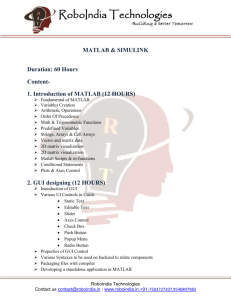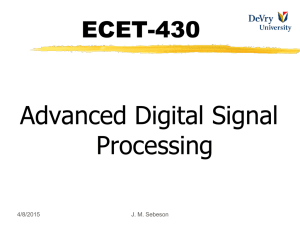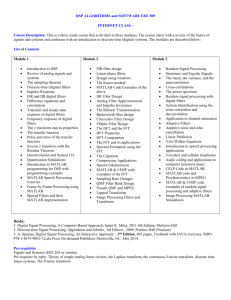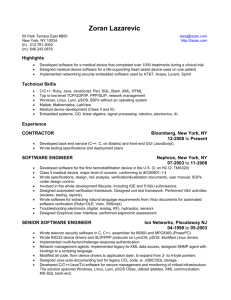interactive dsp education using matlab demos
advertisement
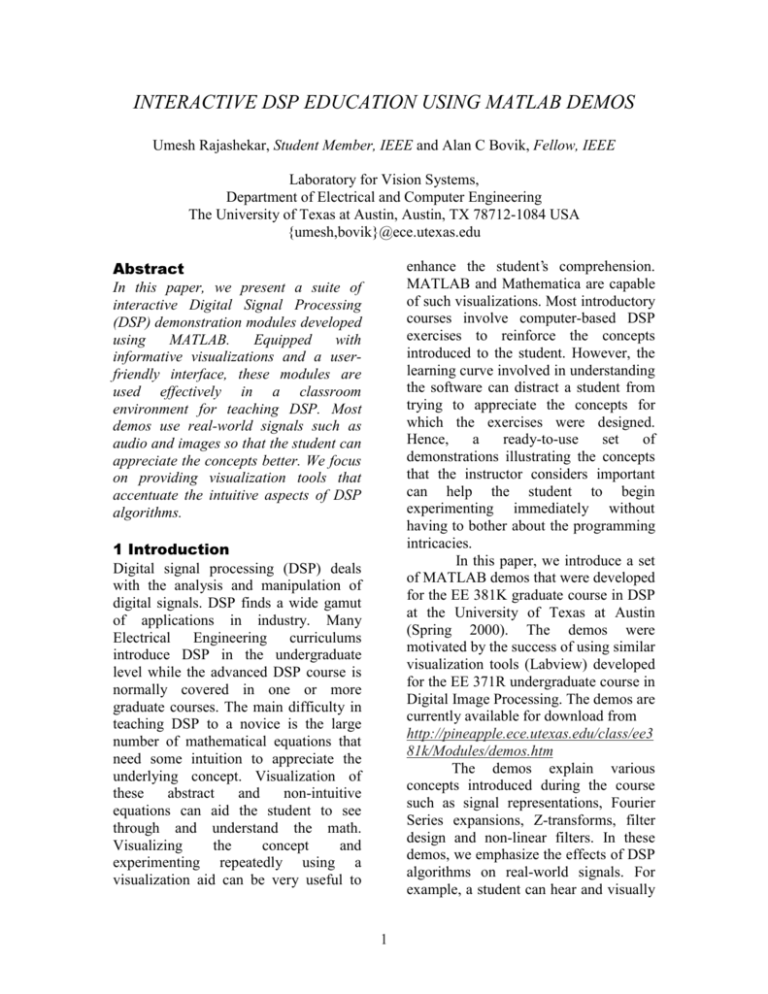
INTERACTIVE DSP EDUCATION USING MATLAB DEMOS
Umesh Rajashekar, Student Member, IEEE and Alan C Bovik, Fellow, IEEE
Laboratory for Vision Systems,
Department of Electrical and Computer Engineering
The University of Texas at Austin, Austin, TX 78712-1084 USA
{umesh,bovik}@ece.utexas.edu
$EVWUDFW
In this paper, we present a suite of
interactive Digital Signal Processing
(DSP) demonstration modules developed
using
MATLAB.
Equipped
with
informative visualizations and a userfriendly interface, these modules are
used effectively in a classroom
environment for teaching DSP. Most
demos use real-world signals such as
audio and images so that the student can
appreciate the concepts better. We focus
on providing visualization tools that
accentuate the intuitive aspects of DSP
algorithms.
enhance the student’s comprehension.
MATLAB and Mathematica are capable
of such visualizations. Most introductory
courses involve computer-based DSP
exercises to reinforce the concepts
introduced to the student. However, the
learning curve involved in understanding
the software can distract a student from
trying to appreciate the concepts for
which the exercises were designed.
Hence,
a
ready-to-use
set
of
demonstrations illustrating the concepts
that the instructor considers important
can help the student to begin
experimenting immediately without
having to bother about the programming
intricacies.
In this paper, we introduce a set
of MATLAB demos that were developed
for the EE 381K graduate course in DSP
at the University of Texas at Austin
(Spring 2000). The demos were
motivated by the success of using similar
visualization tools (Labview) developed
for the EE 371R undergraduate course in
Digital Image Processing. The demos are
currently available for download from
http://pineapple.ece.utexas.edu/class/ee3
81k/Modules/demos.htm
The demos explain various
concepts introduced during the course
such as signal representations, Fourier
Series expansions, Z-transforms, filter
design and non-linear filters. In these
demos, we emphasize the effects of DSP
algorithms on real-world signals. For
example, a student can hear and visually
,QWURGXFWLRQ
Digital signal processing (DSP) deals
with the analysis and manipulation of
digital signals. DSP finds a wide gamut
of applications in industry. Many
Electrical
Engineering
curriculums
introduce DSP in the undergraduate
level while the advanced DSP course is
normally covered in one or more
graduate courses. The main difficulty in
teaching DSP to a novice is the large
number of mathematical equations that
need some intuition to appreciate the
underlying concept. Visualization of
these
abstract
and
non-intuitive
equations can aid the student to see
through and understand the math.
Visualizing
the
concept
and
experimenting repeatedly using a
visualization aid can be very useful to
1
designing filters [4]. MATLAB also has
a number of easy to use plotting and
graphical functions, which make
MATLAB an attractive choice for
developing
attractive
visualization
applications. [3] gives an introduction to
the use of MATLAB. The vectorized
nature of MATLAB, the abundant
collection of functions and visualization
options makes it a good choice for
visualizing DSP concepts. Development
of an educational tool for classroom
instruction needs a powerful Graphical
User Interface (GUI). GUI development
in MATLAB is discussed in Section 3.1.
Current versions of MATLAB also
provide
powerful
user
friendly
debugging tools.
appreciate the effects of aliasing due to
signal undersampling, or the varied
effects of lowpass, bandpass, or highpass
filtering, the effects of using different
types of filter designs, and so on.
There have been similar web
based DSP educational tools developed
using Java [1] and Common Gateway
Interface (CGI) [2]. However, we chose
MATLAB due to the following
attractive
features:
simple
programmability, impressive integrated
graphical functions, highly optimized for
vectorized code (suitable for DSP
algorithms), availability of MATLAB
for a wide variety of platforms, and
extensibility to a web-based education
system such as that used at UT-Austin.
Section 2 gives an overview of
MATLAB. In Section 3, we describe a
few demos that were developed.
Conclusions are given in Section 4.
6\VWHP2YHUYLHZ
Using the powerful graphics and simple
functionality
of
MATLAB,
we
developed
a
number
of
DSP
demonstrations that can be used for a
classroom teaching environment to
demonstrate DSP concepts visually.
Currently all demos run on the Windows
NT 4.0 platform but can be easily ported
onto other platforms too.
2YHUYLHZRI0$7/$%
(The following is with reference to
MATLAB Ver 5.2). MATLAB (MATrix
LABoratory) is a high performance
language for technical computing. It
integrates computation, visualization and
programming
in
an
easy-to-use
environment [3]. The basic data element
in MATLAB is an array. Many matrixbased
functions
like
matrix
multiplication and array dot products can
be executed in a fraction of time it would
take to write a similar program in a
scalar non-interactive language such as
C or FORTRAN. MATLAB features a
family of application specific solutions
called toolboxes for signal processing,
neural networks and wavelets to name a
few. These toolboxes are a collection of
functions written as M-files. The signal
processing toolbox (SPtool) for example
includes an interactive environment for
analyzing and manipulating signals and
3.1 GUI development using MATLAB
MATLAB
provides-GUIDE
(GUI
Design Environment) to develop GUIs
using "drag and drop objects" such as
buttons, sliders and pop-down menus to
name a few. Impressive GUIs can be
developed in a short time. An M-file
performing a particular task for each
object in the GUI is written separately
using many of the in-built MATLAB
functions. The GUIDE callback editor
manages the actions associated with the
selection of a particular object (for e.g.
clicking a button) by linking an object to
its respective M-file. [5] describes the
GUI development in MATLAB. Fig 1
2
user to hear the aliasing of a sinusoid
when it is undersampled at various rates.
3.2.2 Fourier Series
In this demo, a selected standard signal
is decomposed into its constituent
sinusoids and the user can view the
frequency representation of the signal.
The user also has an option of adding
one frequency component at a time to
see how these sinusoids add up to form
the signal under consideration. This can
also be used to illustrate Gibb’s
phenomenon wherein, a square wave is
selected as the input.
3.2.3 Z-transform
This is one of the demos that
demonstrates the powerful graphics
capability of MATLAB. The effect of
zeros and poles on the impulse and
frequency response of a system can be
demonstrated. The user can place poles
and zeros on the Z-plane using the click
of a mouse. The 3D effect (which can be
rotated for any view) of the poles and
zeros can be visualized along with the
other options to view frequency and
impulse responses too. Fig 3 illustrates
the Z-transform demo.
3.2.4 Digital to Analog reconstruction
These demos illustrate digital to analog
reconstruction using Zero order hold,
linear and cubic interpolations. The user
can select any standard signal and
sample it at variable rates and examine
the
reconstructed
signal.
Image
reconstruction using similar techniques
help the user to appreciate visually, the
importance of the type of reconstruction
used.
3.2.5 Filter design
FIR filters - The effects of various
windows for the windowing technique of
FIR filter design is illustrated. The user
can vary the window length and examine
the frequency response of these
windows. A GUI for FIR filter design
shows a typical GUI development
environment.
Once the GUI is developed, one
can use the mouse and on-screen options
to visualize, hear and manipulate signals
(audio and images). We have used a
number of signals that can be analyzed
for e.g. in audio, we use male and female
voices, music and standard waves (sine,
chirp, square, triangle). A few demos
also use images as inputs to illustrate
multidimensional DSP algorithms. All
audio samples used by our demo
modules are .wav files that have been
stored
differently
for
ease
of
programming. For classroom instruction,
the demos are hyperlinked from an MSWord document. MATLAB always runs
the matlab\toolbox\local\matlabrc.m on
startup. We make modifications to this
file so that MATLAB starts up with the
respective demos when the hyperlinks
are clicked. We explain a few of the
demos that were developed in section
3.2.
3.2 Examples of demos
3.2.1 Signal representations
In this introductory module, we focus on
the representations of an input signal in
different domains i.e. in the time,
frequency and the time-frequency
domains. The user can select an audio
sample to be viewed in any of the above
domains, change its sampling frequency
and the number of bits per sample, hear
to the original and the modified signal.
Selecting a chirp signal and sampling it
appropriately can be used to effectively
visualize and hear aliasing as shown in
Fig 2. We have also developed other
simple demos to illustrate the difference
between continuous, discrete time and
digital signals. Another demo helps a
3
copy of MATLAB. MATLAB server
can be used to run the demos on a server
and the results can be displayed at the
client end. This would obviate the need
for a local copy of MATLAB at the
client end. More information on the
MATLAB server can be got from
http://www.mathworks.com/products/we
bserver/
using windows allows the user to specify
the window to be used, the filter order
and other frequency specs for filter
design. The designed filter can be
applied to an input signal to hear the
effect of the filter on the audio sample.
The magnitude and phase response of
the filter can be viewed too. We have
similar demos for FIR filter design using
frequency
sampling
and
Remez
exchange algorithm.
IIR filters - The GUI for IIR
filters is similar to the one used for the
FIR case except that the design is now
using analog prototypes such as
Butterworth, Chebyshev and Elliptical
filters. The bilinear transformation is
used for converting the analog filters to
the digital domain. The minimum filter
order is obtained using the "Auto"
design mode. The pole zero plot can be
also be viewed for the designed filter.
Besides the examples discussed
above, we also have developed a number
of other demos to explain concepts in
Discrete Fourier transforms, multirate
DSP, short time Fourier transforms etc.
A median filter demo (for audio and
images) is also developed to illustrate
the superior performance of non-linear
filters over linear systems.
5HIHUHQFHV
1. Cheneval Y., Balmelli L., Prandoni
P., Kovacevic J. and Vetterli M.,
"Interactive DSP education using
Java," In Proceedings of the 1998
IEEE International Conference on
Acoustics, Speech and Signal
Processing, 1998. Vol 3 , Page(s):
1905 -1908
2. Rahkila M., Karjalainen M. "An
interactive DSP tutorial on the
Web,"
IEEE
International
Conference on Acoustics, Speech,
and Signal Processing, 1997.
ICASSP-97., Vol 3, 1997 , Page(s):
2253 -2256
3. ___, "Getting started with MATLABVersion 5," The Mathworks Inc May
1997
4. ___, "MATLAB Signal Processing
Toolbox," The Mathworks Inc Dec
1996
5. ___, "Building GUIs with MATLABVersion 5," The Mathworks Inc June
1997
&RQFOXVLRQV
In this paper, we discussed the
development of MATLAB based demos
for the visualization of DSP concepts.
Currently the demos have to be
downloaded and therefore need a local
4
Fig 1:GUI development in MATLAB
Fig 2: Signal representations (aliasing in chirp shown)
5
1: representation
GUI development
MATLAB
FigureFigure
2:Signal
GUIin(aliasing
in chirp signal)
Fig 3: GUI for Z-transforms (Z-plane,3D, frequency and impulse response)
6
